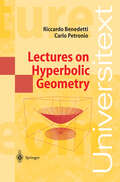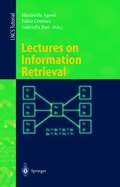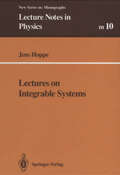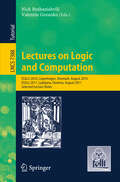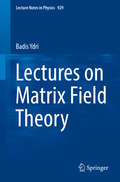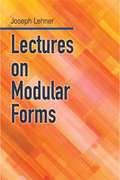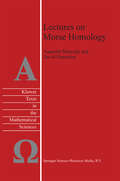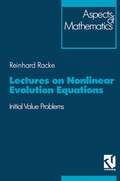- Table View
- List View
Lectures on Hyperbolic Geometry (Universitext)
by Riccardo Benedetti Carlo PetronioFocussing on the geometry of hyperbolic manifolds, the aim here is to provide an exposition of some fundamental results, while being as self-contained, complete, detailed and unified as possible. Following some classical material on the hyperbolic space and the Teichmüller space, the book centers on the two fundamental results: Mostow's rigidity theorem (including a complete proof, following Gromov and Thurston) and Margulis' lemma. These then form the basis for studying Chabauty and geometric topology; a unified exposition is given of Wang's theorem and the Jorgensen-Thurston theory; and much space is devoted to the 3D case: a complete and elementary proof of the hyperbolic surgery theorem, based on the representation of three manifolds as glued ideal tetrahedra.
Lectures on Hyperhamiltonian Dynamics and Physical Applications (Mathematical Physics Studies)
by Giuseppe Gaeta Miguel A. RodríguezThis book provides the mathematical foundations of the theory of hyperhamiltonian dynamics, together with a discussion of physical applications. In addition, some open problems are discussed. Hyperhamiltonian mechanics represents a generalization of Hamiltonian mechanics, in which the role of the symplectic structure is taken by a hyperkähler one (thus there are three Kähler/symplectic forms satisfying quaternionic relations). This has proved to be of use in the description of physical systems with spin, including those which do not admit a Hamiltonian formulation. The book is the first monograph on the subject, which has previously been treated only in research papers.
Lectures on Hyponormal Operators (Operator Theory: Advances and Applications #39)
by Mihai Putinar Mircea MartinLectures on Inductive Logic
by Jon WilliamsonLogic is a field studied mainly by researchers and students of philosophy, mathematics and computing. Inductive logic seeks to determine the extent to which the premisses of an argument entail its conclusion, aiming to provide a theory of how one should reason in the face of uncertainty. It has applications to decision making and artificial intelligence, as well as how scientists should reason when not in possession of the full facts. In this book, Jon Williamson embarks on a quest to find a general, reasonable, applicable inductive logic (GRAIL), all the while examining why pioneers such as Ludwig Wittgenstein and Rudolf Carnap did not entirely succeed in this task. Along the way he presents a general framework for the field, and reaches a new inductive logic, which builds upon recent developments in Bayesian epistemology (a theory about how strongly one should believe the various propositions that one can express). The book explores this logic in detail, discusses some key criticisms, and considers how it might be justified. Is this truly the GRAIL? Although the book presents new research, this material is well suited to being delivered as a series of lectures to students of philosophy, mathematics, or computing and doubles as an introduction to the field of inductive logic
Lectures on Inductive Logic
by Jon WilliamsonLogic is a field studied mainly by researchers and students of philosophy, mathematics and computing. Inductive logic seeks to determine the extent to which the premisses of an argument entail its conclusion, aiming to provide a theory of how one should reason in the face of uncertainty. It has applications to decision making and artificial intelligence, as well as how scientists should reason when not in possession of the full facts. In this book, Jon Williamson embarks on a quest to find a general, reasonable, applicable inductive logic (GRAIL), all the while examining why pioneers such as Ludwig Wittgenstein and Rudolf Carnap did not entirely succeed in this task. Along the way he presents a general framework for the field, and reaches a new inductive logic, which builds upon recent developments in Bayesian epistemology (a theory about how strongly one should believe the various propositions that one can express). The book explores this logic in detail, discusses some key criticisms, and considers how it might be justified. Is this truly the GRAIL? Although the book presents new research, this material is well suited to being delivered as a series of lectures to students of philosophy, mathematics, or computing and doubles as an introduction to the field of inductive logic
Lectures on Information Retrieval: Third European Summer-School, ESSIR 2000 Varenna, Italy, September 11-15, 2000. Revised Lectures (Lecture Notes in Computer Science #1980)
by Maristella Agosti Fabio Crestani Gabriella PasiInformation Retrieval (IR) is concerned with the effective and efficient retrieval of information based on its semantic content. The central problem in IR is the quest to find the set of relevant documents, among a large collection containing the information sought, satisfying a user's information need usually expressed in a natural language query. Documents may be objects or items in any medium: text, image, audio, or indeed a mixture of all three. This book presents 12 revised lectures given at the Third European Summer School in Information Retrieval, ESSIR 2000, held at the Villa Monastero, Varenna, Italy, in September 2000. The first part of the book is devoted to the foundation of IR and related areas; the second part on advanced topics addresses various current issues, from usability aspects to Web searching and browsing.
Lectures on Insurance Models (Texts and Readings in Mathematics)
by S. RamasubramanianInsurance has become a necessary aspect of modern society. The mathematical basis of insurance modeling is best expressed in terms of continuous time stochastic processes. This introductory text on actuarial risk theory deals with the Cramer-Lundberg model and the renewal risk model. Their basic structure and properties, including the renewal theorems as well as the corresponding ruin problems, are studied. There is a detailed discussion of heavy tailed distributions, which have become increasingly relevant. The Lundberg risk process with investment in risky asset is also considered. This book will be useful to practitioners in the field and to graduate students interested in this important branch of applied probability.
Lectures on Integrable Systems (Lecture Notes in Physics Monographs #10)
by Jens HoppeMainly drawing on explicit examples, the author introduces the reader to themost recent techniques to study finite and infinite dynamical systems. Without any knowledge of differential geometry or lie groups theory the student can follow in a series of case studies the most recent developments. r-matrices for Calogero-Moser systems and Toda lattices are derived. Lax pairs for nontrivial infinite dimensionalsystems are constructed as limits of classical matrix algebras. The reader will find explanations of the approach to integrable field theories, to spectral transform methods and to solitons. New methods are proposed, thus helping students not only to understand established techniques but also to interest them in modern research on dynamical systems.
Lectures on Kinetic Processes in Materials
by Han-Ill YooThis book provides beginning graduate or senior-level undergraduate students in materials disciplines with a primer of the fundamental and quantitative ideas on kinetic processes in solid materials. Kinetics is concerned with the rate of change of the state of existence of a material system under thermodynamic driving forces. Kinetic processes in materials typically involve chemical reactions and solid state diffusion in parallel or in tandem. Thus, mathematics of diffusion in continuum is first dealt with in some depth, followed by the atomic theory of diffusion and a brief review of chemical reaction kinetics. Chemical diffusion in metals and ionic solids, diffusion-controlled kinetics of phase transformations, and kinetics of gas-solid reactions are examined. Through this course of learning, a student will become able to predict quantitatively how fast a kinetic process takes place, to understand the inner workings of the process, and to design the optimal process of material state change.Provides students with the tools to predict quantitatively how fast a kinetic process takes place and solve other diffusion related problems;Learns fundamental and quantitative ideas on kinetic processes in solid materials;Examines chemical diffusion in metals and ionic solids, diffusion-controlled kinetics of phase transformations, and kinetics of gas-solid reactions, among others;Contains end-of chapter exercise problems to help reinforce students' grasp of the concepts presented within each chapter.
Lectures on LHC Physics (Lecture Notes in Physics #886)
by Tilman PlehnWith the discovery of the Higgs boson, the LHC experiments have closed the most important gap in our understanding of fundamental interactions, confirming that such interactions between elementary particles can be described by quantum field theory, more specifically by a renormalizable gauge theory. This theory is a priori valid for arbitrarily high energy scales and does not require an ultraviolet completion.Yet, when trying to apply the concrete knowledge of quantum field theory to actual LHC physics - in particular to the Higgs sector and certain regimes of QCD - one inevitably encounters an intricate maze of phenomenological know-how, common lore and other, often historically developed intuitions about what works and what doesn’t.These lectures cover three aspects to help understand LHC results in the Higgs sector and in searches for physics beyond the Standard Model: they discuss the many facets of Higgs physics, which is at the core of this significantly expanded second edition; then QCD, to the degree relevant for LHC measurements; as well as further standard phenomenological background knowledge. They are intended to serve as a brief but sufficiently detailed primer on LHC physics to enable graduate students and all newcomers to the field to find their way through the more advanced literature, and to help those starting to work in this very timely and exciting field of research. Advanced readers will benefit from this course-based text for their own lectures and seminars..
Lectures on Logic and Computation: ESSLLI 2010, Copenhagen, Denmark, August 2010, ESSLLI 2011, Ljubljana, Slovenia, August 2011, Selected Lecture Notes (Lecture Notes in Computer Science #7388)
by Nick Bezhanishvili Valentin GorankoThe European Summer School in Logic, Language and Information (ESSLLI) is organized every year by the Association for Logic, Language and Information (FoLLI) in different sites around Europe. The main focus of ESSLLI is on the interface between linguistics, logic and computation. ESSLLI offers foundational, introductory and advanced courses, as well as workshops, covering a wide variety of topics within the three areas of interest: Language and Computation, Language and Logic, and Logic and Computation. During two weeks, around 50 courses and 10 workshops are offered to the attendants, each of 1.5 hours per day during a five days week, with up to seven parallel sessions. ESSLLI also includes a student session (papers and posters by students only, 1.5 hour per day during the two weeks) and four evening lectures by senior scientists in the covered areas. The 6 course notes were carefully reviewed and selected. The papers are organized in topical sections on computational complexity, multi-agant systems, natural language processing, strategies in games and formal semantics.
Lectures on Mappings of Finite Distortion (Lecture Notes in Mathematics #2096)
by Stanislav Hencl Pekka KoskelaIn this book we introduce the class of mappings of finite distortion as a generalization of the class of mappings of bounded distortion. Connections with models of nonlinear elasticity are also discussed. We study continuity properties, behavior of our mappings on null sets, topological properties like openness and discreteness, regularity of the potential inverse mappings and many other aspects.
Lectures on Mathematical Theory of Extremum Problems (Lecture Notes in Economics and Mathematical Systems #67)
by I. V. GirsanovThe author of this book, Igor' Vladimirovich Girsanov, was one of the first mathematicians to study general extremum problems and to realize the feasibility and desirability of a unified theory of extremal problems, based on a functional analytic approach. He actively advocated this view, and his special course, given at the Faculty of Mechanics and Mathematics of the Moscow State University in 1963 and 1964, was apparently the first systematic exposition of a unified approach to the theory of extremal problems. This approach was based on the ideas of Dubovitskii and Milyutin [1]. The general theory of extremal problems has developed so intensely during the past few years that its basic concepts may now be considered finalized. Nevertheless, as yet the basic results of this new field of mathematics have not been presented in a form accessible to a wide range of readers. (The profound paper of Dubovitskii and Milyutin [2] can hardly be recommended for a first study of the theory, since, in particular, it does not contain proofs of the fundamental theorems. ) Girsanov's book fills this gap. It contains a systematic exposition of the general principles underlying the derivation of necessary and sufficient conditions for an extremum, in a wide variety of problems. Numerous applications are given to specific extremal problems. The main material is preceded by an introductory section in which all prerequisites from functional analysis are presented.
Lectures on Matrix Field Theory (Lecture Notes in Physics #929)
by Badis YdriThese lecture notes provide a systematic introduction to matrix models of quantum field theories with non-commutative and fuzzy geometries. The book initially focuses on the matrix formulation of non-commutative and fuzzy spaces, followed by a description of the non-perturbative treatment of the corresponding field theories. As an example, the phase structure of non-commutative phi-four theory is treated in great detail, with a separate chapter on the multitrace approach. The last chapter offers a general introduction to non-commutative gauge theories, while two appendices round out the text. Primarily written as a self-study guide for postgraduate students – with the aim of pedagogically introducing them to key analytical and numerical tools, as well as useful physical models in applications – these lecture notes will also benefit experienced researchers by providing a reference guide to the fundamentals of non-commutative field theory with an emphasis on matrix models and fuzzy geometries.
Lectures on Modular Forms
by Joseph J. LehnerThis concise volume presents an expository account of the theory of modular forms and its application to number theory and analysis. Suitable for advanced undergraduates and graduate students in mathematics, the treatment starts with classical material and leads gradually to modern developments. Prerequisites include a grasp of the elements of complex variable theory, group theory, and number theory. The opening chapters define modular forms, develop their most important properties, and introduce the Hecke modular forms. Subsequent chapters explore the automorphisms of a compact Riemann surface, develop congruences and other arithmetic properties for the Fourier coefficients of Klein's absolute modular invariant, and discuss analogies with the Hecke theory as well as with the Ramanujan congruences for the partition function. Substantial notes at the end of each chapter provide detailed explanations of the text's more difficult points.
Lectures on Modular Forms. (AM-48), Volume 48
by Robert C. GunningNew interest in modular forms of one complex variable has been caused chiefly by the work of Selberg and of Eichler. But there has been no introductory work covering the background of these developments. H. C. Gunning's book surveys techniques and problems; only the simpler cases are treated-modular forms of even weights without multipliers, the principal congruence subgroups, and the Hecke operators for the full modular group alone.
Lectures on Modules and Rings (Graduate Texts in Mathematics #189)
by Tsit-Yuen LamThis new book can be read independently from the first volume and may be used for lecturing, seminar- and self-study, or for general reference. It focuses more on specific topics in order to introduce readers to a wealth of basic and useful ideas without the hindrance of heavy machinery or undue abstractions. User-friendly with its abundance of examples illustrating the theory at virtually every step, the volume contains a large number of carefully chosen exercises to provide newcomers with practice, while offering a rich additional source of information to experts. A direct approach is used in order to present the material in an efficient and economic way, thereby introducing readers to a considerable amount of interesting ring theory without being dragged through endless preparatory material.
Lectures on Morse Homology (Texts in the Mathematical Sciences #29)
by Augustin Banyaga David HurtubiseThis book offers a detailed presentation of results needed to prove the Morse Homology Theorem using classical techniques from algebraic topology and homotopy theory. The text presents results that were formerly scattered in the mathematical literature, in a single reference with complete and detailed proofs. The core material includes CW-complexes, Morse theory, hyperbolic dynamical systems (the Lamba-Lemma, the Stable/Unstable Manifold Theorem), transversality theory, the Morse-Smale-Witten boundary operator, and Conley index theory.
Lectures on n-Dimensional Quasiconformal Mappings (Lecture Notes in Mathematics #229)
by Jussi VäisäläLectures on Non-linear Plasma Kinetics (Springer Series on Atomic, Optical, and Plasma Physics #17)
by Vadim N. TsytovichLectures on Non-linear Plasma Kinetics is an introduction to modern non-linear plasma physics showing how many of the techniques of modern non-linear physics find applications in plasma physics and how, in turn, the results of this research find applications in astrophysics. Emphasis is given to explaining the physics of nonlinear processes and the radical change of cross-sections by collective effects. The author discusses new nonlinear phenomena involving the excitation of coherent nonlinear structures and the dynamics of their random motions in relation to new self-organization processes. He also gives a detailed description of applications of the general theory to various research fields, including the interaction of powerful radiation with matter, controlled thermonuclear research, etc.
Lectures on Non- Standard Analysis (Lecture Notes in Mathematics #94)
by Moshe Machover Joram HirschfeldLectures on Nonlinear Evolution Equations: Initial Value Problems
by Reinhard RackeThis book mainly serves as an elementary, self-contained introduction to several important aspects of the theory of global solutions to initial value problems for nonlinear evolution equations. The book employs the classical method of continuation of local solutions with the help of a priori estimates obtained for small data. The existence and uniqueness of small, smooth solutions that are defined for all values of the time parameter are investigated. Moreover, the asymptotic behaviour of the solutions is described as time tends to infinity. The methods for nonlinear wave equations are discussed in detail. Other examples include the equations of elasticity, heat equations, the equations of thermoelasticity, Schrödinger equations, Klein-Gordon equations, Maxwell equations and plate equations. To emphasize the importance of studying the conditions under which small data problems offer global solutions, some blow-up results are briefly described. Moreover, the prospects for corresponding initial boundary value problems and for open questions are provided.In this second edition, initial-boundary value problems in waveguides are additionally considered.
Lectures on Nonlinear Evolution Equations: Initial Value Problem (Aspects of Mathematics #19)
by Reinhard RackeThis book serves as an elementary, self contained introduction into some important aspects of the theory of global solutions to initial value problems for nonlinear evolution equations. The presentation is made using the classical method of continuation of local solutions with the help of a priori estimates obtained for small data.
Lectures on Nonsmooth Differential Geometry (SISSA Springer Series #2)
by Nicola Gigli Enrico PasqualettoThis book provides an introduction to some aspects of the flourishing field of nonsmooth geometric analysis. In particular, a quite detailed account of the first-order structure of general metric measure spaces is presented, and the reader is introduced to the second-order calculus on spaces – known as RCD spaces – satisfying a synthetic lower Ricci curvature bound. Examples of the main topics covered include notions of Sobolev space on abstract metric measure spaces; normed modules, which constitute a convenient technical tool for the introduction of a robust differential structure in the nonsmooth setting; first-order differential operators and the corresponding functional spaces; the theory of heat flow and its regularizing properties, within the general framework of “infinitesimally Hilbertian” metric measure spaces; the RCD condition and its effects on the behavior of heat flow; and second-order calculus on RCD spaces. The book is mainly intended for young researchers seeking a comprehensive and fairly self-contained introduction to this active research field. The only prerequisites are a basic knowledge of functional analysis, measure theory, and Riemannian geometry.
